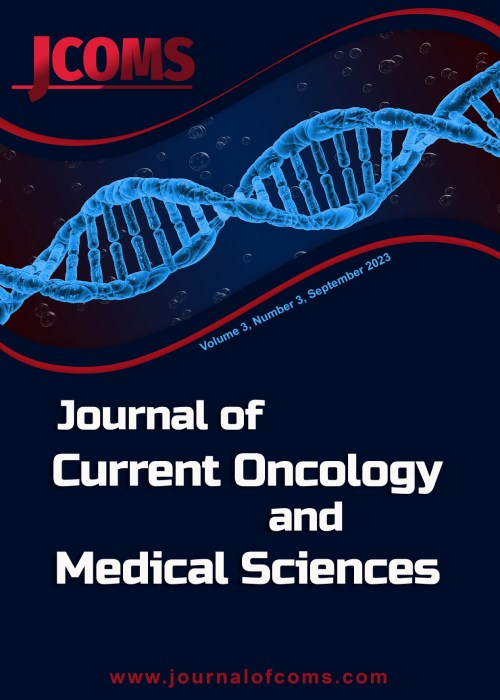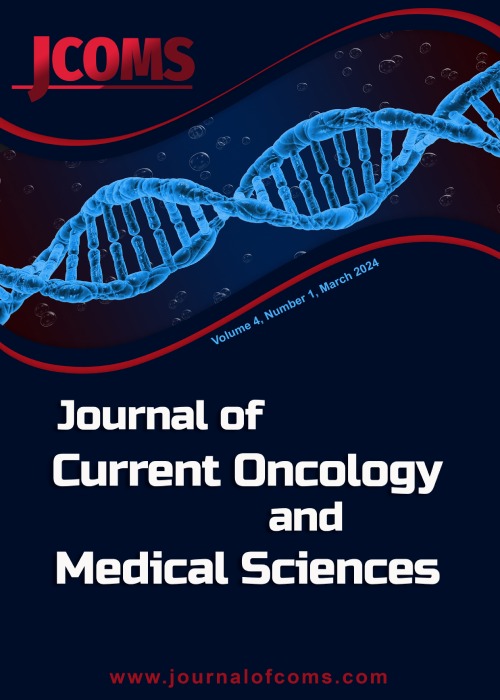فهرست مطالب

Journal of Current Oncology and Medical Sciences
Volume:3 Issue: 3, Summer 2023
- تاریخ انتشار: 1402/08/20
- تعداد عناوین: 7
-
Pages 505-520
Cancer immunotherapy aims to modify and improve the immune systems’ fight against cancer, it is a highly promising and evolving field. It is effective at treating a wide range of cancers, suppressing tumor growth and improving survival rate of cancer patients. Despite the promise and fervor around cancer immunotherapy, many challenges have limited their widespread use and efficacy. In this review article, we consider novel cancer immunotherapies, encouraging clinical trials and innovative strategies employed in developing safe and effective cancer immunotherapies. It is safe to say that cancer immunotherapy has revolutionized cancer therapy, but there are hurdles and challenges (toxicity concerns being the most notable) that must be overcome for safer and more effective treatment strategies. The battle against cancer is an arduous and prolonged affair. We aim to point out what we have achieved in recent times and outline potential strategies to mitigate our losses and chart a course of victory.
Keywords: Cancer, Immunotherapy, Clinical trials, T-cells, Antibody -
Pages 521-525Introduction
Giant cell tumours of the soft tissue (GCT-ST) are usually found in the superficial and deep soft tissues of the extremities but have been described in the pancreas, lung, thyroid gland, urothelial tract, skin, larynx, heart and very rarely, in the breast. At present, according to the World Health Organization's classification of soft tissue tumors, GCT-ST is categorized as an intermediate grade (rarely metastasizing) fibrohistiocytic tumour. GCT of the breast is extremely rare and to date, only eleven cases have been reported. We report a case of GCT of the breast, which was clinically suspected as a malignant tumor and discuss the different treatment modalities with the importance of close follow-up of the same after a thorough review of the literature.
Case PresentationWe report a case of a 45-year-old woman who noticed a tender lump in her left breast. A malignant tumour was suspected on clinical examination and imaging. Histological evaluation revealed a tumour composed of a mixture of round and oval mononuclear cells with minimal atypia and uniformly distributed multinucleated osteoclast-like giant cells (OGCs) with a stroma rich in blood vessels. IHC was done in which the OGCs stained positively for CD68 and CD45, mononuclear stromal cells were positive for vimentin whereas the tumour was negative for breast markers Progesterone Receptor (PR), Estrogen Receptor (ER), GATA 3, epithelial marker EMA, S-100 and Desmin; hence the definitive diagnosis of GCT of the breast was made.
DiscussionGCT of the breast, due to its rareness and the malignant-mimicking clinical presentation, causes difficulty in diagnosis. Other giant cell-rich lesions including breast cancer with OGCs, pleomorphic leiomyosarcoma, osteosarcoma, undifferentiated pleomorphic sarcoma and metastatic GCT-B are to be considered in the differential diagnosis.
ConclusionGCT of the breast is an extremely rare tumour and pretends a breast malignant tumours. For the correct diagnosis of this rare tumour, combining the results of histological and immunohistochemical analyses helps in ruling out differential diagnosis.
Keywords: Giant cell tumor, Osteoclastic giant cells, Breast, Immunohistochemistry -
Pages 526-531Introduction
Agaricus blazei mushroom is used as a food and medicine, its effective composition is beta-glucan, which is used to treat some cancers and infections, including hepatitis C.Hepatitis C is an inflammatory disease that causes liver necrosis. Caspase2 protein is one of the factors promoting cell apoptosis and plays a role in tumor suppression. The purpose of this study is to determine the expression changes of the caspase2 gene and its effects on liver cancer.
Materials and MethodsIn this project, raw expression data was obtained from the NCBI (National Center for Biotechnology Information) GEO (Gene Expression Omnibus) database section and using bioinformatics tools and methods and system biology such as Matlab (An abbreviation of "MATrix LABoratory), GEOR2 (Online software) and Cytoscape, the effect of consuming the desired mushroom on caspase2 gene expression was investigated.
ResultsIt was found that the beta-glucan combination has an increasing effect on target gene expression (p-value=0.05692).
ConclusionThe results show that the beta-glucan present in the mushroom can play a role as a prevention and even treatment of liver cancer by increasing the expression of caspase 2 protein by directing the damaged cell towards apoptosis.
Keywords: Beta-glucan, Agaricus blazei, Hepatitis C, Caspase 2, Microarray, System biology -
Pages 532-540Introduction
Low background radiation levels are constantly around us, but generally there are some high natural background radiation areas (HNBRAs) in the world including Ramsar in Iran, Guarapari in Brazil, Kerala in India, Arkaroola in Australia, and Yangjiang in China. The present study aims to explore the relationship between living in HNBRAs and cancer mortality rate.
Materials and MethodsA perfect search was conducted in Google Scholar, Scopus, PubMed, and databases and articles with the key terms "High natural background radiation", "cancer prevalence in HNBRAs", " natural radiation" and " mortality" using MeSH.
ResultsThe results of this study are based on articles published in national and international journals, dissertations, and reference sites. In a total of 156 documents, 33 (21.15%) were selected.
ConclusionMore recent studies have highlighted the absence of any direct connection between high natural background radiation and the prevalence of cancer in people living in HNBRAs. Some studies have suggested that low natural background radiation is not only harmless but may be beneficial to health through adaptations, while others believe that even the smallest doses of radiation are harmful.
Keywords: Cancer, Natural radiation, High natural background radiation areas, Ramsar, Mortality -
Pages 541-549Introduction
Termination of pregnancy through curettage in the first trimester requires cervical ripening (CR) which can be induced by medicinal or mechanical methods. In the pharmaceutical method, vaginal administration of misoprostol, as well as vaginal trinitroglycerin (TNG), has been shown to induce effective CR. This study was conducted with the aim of comparing vaginal misoprostol and vaginal TNG in the CR of women candidates for the first-trimester curettage.
Materials and MethodsThis double-blind clinical trial study was conducted on 168 pregnant women with a gestational age of less than 14 weeks who were candidates for curettage. Participants were randomly divided into two groups receiving vaginally either TNG (400 µgr)(n=87) or misoprostol (400 µgr) (n=81). Then, the state of CR and the need for mechanical dilatation were compared between the two groups. Also, the presence of any side effects caused by drug use was determined.
ResultsThe percentage of CR in the misoprostol group (67.9%) was significantly higher than in the TNG group (32.2%) (P<0.001). Therefore, the need for mechanical dilatation in the TNG group (66.7%) was significantly higher compared with the misoprostol group (32.1%) (P<0.001). Also, the rate of complications like diarrhea (9.9%) and abdominal pain (7.4%) in the misoprostol group was significantly higher than in the TNG group (0%). However, headache in the TNG group (34.5%) was significantly higher than in the misoprostol group (0%) (P>0.001). Generally, the rate of complications in the TNG group (35.6%) was significantly higher compared with the misoprostol group (13.6%) (P>0.001).
ConclusionVaginally Misoprostol is more effective than vaginally TNG on CR of first-trimester curettage as well as it significantly reduces the need for mechanical dilatation of the cervix.
Keywords: Misoprostol, Trinitroglycerin, Cervical ripening -
Pages 550-564Introduction
Coronavirus 2019 (COVID-19) was first reported in December 2019 in Wuhan, China, and on January 30, 2020, the World Health Organization (WHO) declared the outbreak of COVID-19 to be an international concern. Many governments around the world quarantined and forced millions to stay at home and remain isolated for long periods, an unprecedented impact on public life. Patients who have undergone bariatric surgery are no exception but are more vulnerable to the effects of isolation. This review study was conducted to help better understand the consequences of the COVID-19 virus pandemic on the weight outcomes of patients after bariatric surgery.
Materials & MethodsThis review study examined the data from several reliable databases such as Google Scholar, Scopus, and Science Direct from the beginning of the coronavirus pandemic (2019) until now (2023). According to the inclusion criteria, finally, 17 articles were reviewed.
ResultsThe findings of this study showed that increased psychological distress, anxiety, depression and loneliness, mood changes, decreased physical activity, decreased social support and loss of face-to-face meetings with a nutrition consultant, increased substance use Unhealthy diet, increased snacking and overeating, as well as loss of control over eating, are some of the adverse effects of coronavirus pandemic on patients who have undergone bariatric surgery, and these are risk factors for weight gain after bariatric surgery.
ConclusionPatients who have undergone bariatric surgery are affected by the COVID-19 virus pandemic and subsequent quarantine and social isolation in many areas of their lives, which will ultimately have a negative impact on the weight outcomes of patients after surgery. Therefore, specialized care and interventions are needed to address behaviors that lead to weight regain during future pandemics or in the post-coronavirus era in vulnerable patients after bariatric surgery.
Keywords: Coronavirus, Weight outcomes, Bariatric surgery -
Pages 565-574Introduction
Liver transplantation is a widely distinguished and highly practical therapy for liver cirrhosis. In any case, liver transplant surgery assumes a risk of influential complications. In this way, the survival rate of liver transplant patients at Razi Healing Center in Rasht from 2017 to 2022 was investigated.
Materials and MethodsIn this retrospective cohort study, liver transplant patients referred to Razi Hospital in Rasht, Iran, from 2017 to 2022 were studied. Patient demographic and clinical information were collected. Survival was determined using Kaplan-Meier estimates. Log rank was used to determine differences between study groups in survival.
ResultsOut of 46 patients who underwent liver transplantation surgery, 54.3% of patients survived. Also, the most common causes of death for the samples of this study were COVID-19 and hemorrhage. Patients with autoimmune cirrhosis due to hepatitis have a significantly higher risk of death than those with cirrhosis due to other factors. Postoperative vascular thrombosis was found to be significantly associated with reduced patient survival. Patient outcomes improved significantly in the second part of the six-year liver transplant study. The study highlights the importance of increasing experience in liver transplant surgery and postoperative care to improve outcomes.
ConclusionAccording to the results of this study, patients with autoimmune cirrhosis due to hepatitis have a higher risk of death than those with cirrhosis due to other causes. In addition, postoperative vascular thrombosis is believed to significantly reduce patient survival. The study highlights the importance of increasing experience in liver transplant surgery and postoperative care to improve outcomes for these patients.
Keywords: Liver transplant, Surgery, Survival, Liver failure


